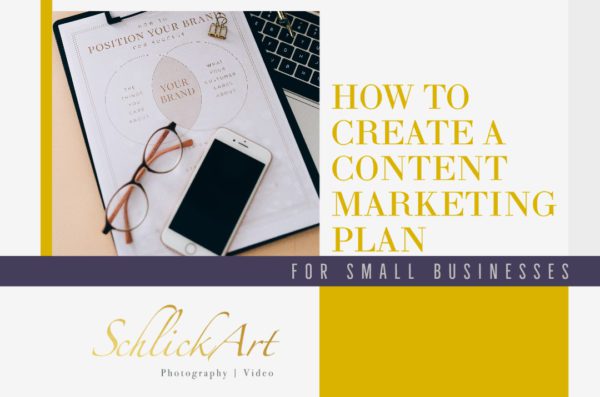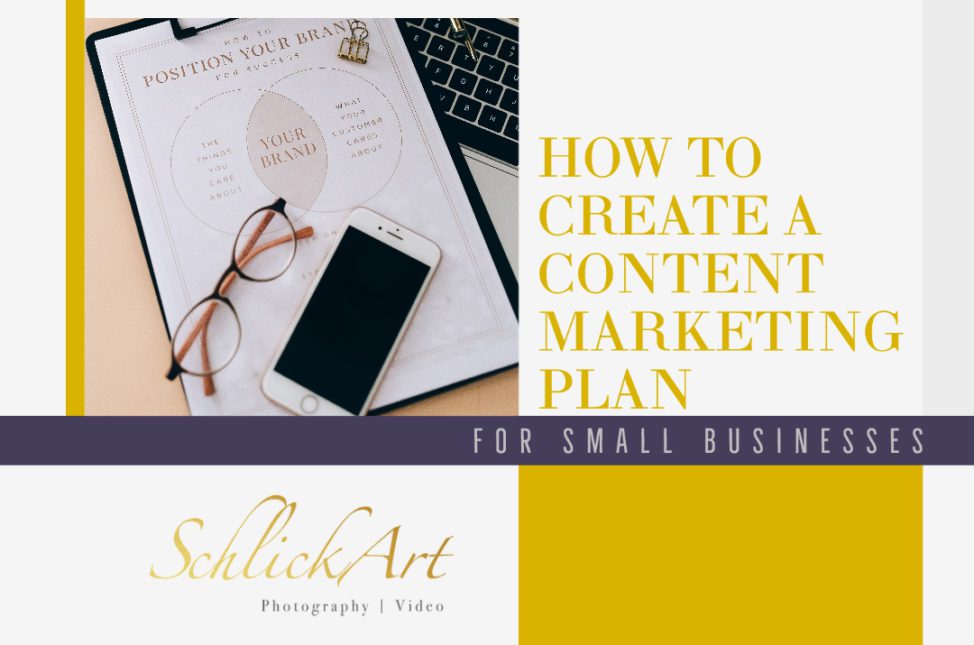Need a strategy for 2022? Here are 10 steps to creating and executing a successful content marketing plan for small businesses.

Today’s digital marketing demands make it feel like you have to be everywhere – all the time.
Websites. Email marketing. Facebook. Instagram. TikTok. YouTube. SEO. Blogs. Videos. Podcasts.
The opportunities to get in front of your audience are endless.
And sometimes, that makes marketing your business feel downright impossible.
But here’s the thing. It’s not.
It just requires some planning, and some dedicated resources.
This is something we do each year, and we’ve found a content marketing system that works for us – without creating too much work for our team.
And that’s what we hope this Content Marketing Plan for Small Businesses helps you achieve in the new year.
This plan is designed to help you identify your goals, create a roadmap to success, and execute each step with purpose. No experience necessary.
So let’s dive in!
What’s A Content Marketing Plan?
 In 2022, a marketing strategy is no small thing.
In 2022, a marketing strategy is no small thing.
Think about all the things you need for your marketing goals to go off without a hitch: people, time, ideas, systems, software, photos, videos, podcasts, scripts, websites, social media posts, etc.
Now ask yourself: Do you want to be searching for those things when you need them? Or do you want to have them organized and planned out ahead of time?
That is what a Content Marketing Plan for small businesses can do for you.
It looks at the why, what and how of creating marketing content for the year ahead.
Not only does it set you up for success, but it also serves as a reminder of why you’re doing all this in the first place. Plus it serves as a checkpoint to see if your efforts are actually working.
Needless to say, we think it’s pretty important.
That’s why we’ve broken it down in 10 steps that you can tackle with your team, or with the help of a trusted friend or mentor.
So grab something to write with – and someone to bounce ideas off of – and get started!
How To Create A Content Marketing Plan For Small Businesses

1. Brainstorm
One of the things we often miss at the start of a project is the big picture.
We might see a strategy we want to try or a video we think would be great, but we fail to look at the bigger picture.
What is the purpose of this strategy? What do I hope it achieves? And why?
That’s why the first step is a good old-fashioned brainstorming session.
Before you even get started, you need to spend time thinking about each of these questions, and jot down some ideas. You don’t have to have all the answers yet. Just make sure these questions are part of the initial conversation.
- What’s the purpose of your marketing? What do you hope to achieve? Think big picture.
- Who will be consuming your content? Who is your audience, and who do you want your audience to be?
- What problem can you solve with your content? How can you make a difference in people’s lives? What value can you bring?
- What makes you and your brand unique? What do you do better or differently than anyone else? What do you have to offer that no one else does? (Hint: You have plenty of insight and expertise to offer the world!)
- What content types are you interested in creating? What content types would resonate with your audience most?
- How will you get your content out there? What channels are you using already? What’s working? What’s not working?
- How can you find support to bring this vision to life? Consider people, tools, software, systems, etc. What resources will you need to make this happen?
2. Know Your Purpose
After your brainstorming session, the ideas should be flowing, and you should have some idea of what you want to accomplish and why.
The next step is to determine your big-picture goal, or your purpose, for your marketing plan. This is not your specific goals – we’ll get to that in a second. Instead, it’s more like your mission statement. It’s the guiding principle that lets you know you’re heading in the right direction.
For example, you purpose could be:
- To provide education to your clients and community
- To create brand awareness in a new audience
- To grow one or more revenue streams
- To update and upgrade your brand
- To create a community of loyal fans
- To change the way the world thinks about your industry or profession
- To bring people together under a common cause or idea
- The options are endless! What drives you?
3. Define Your Goals
Once you know your big-picture purpose, it’s time to break that down into the smaller, achievable goals that will get you there. For example, if your goal is to update your brand, then you might set goals to redesign your logo, refresh your print marketing materials, complete a website update, and improve your customer experience.
Whatever goals you set – make sure you know what it looks like to successfully achieve them, too. Key Performance Indicators, or KPIs, are like benchmarks that you can set to make sure you’ve accomplished your goal.
For example, if your goal is to drive more traffic to your website, then a KPI might be the number of new visitors on your website, as well as the average time users spend on your website. If your goal is to improve customer experience, then a KPI might be the number of five-star reviews or repeat customers you have each month.
Don’t just set specific goals – make sure you know what it looks like to achieve them, too.

4. Do Your Research
Once you have your goals firmly in place, it’s time to take action! As with any good plan, this one starts with adequate research and preparation:
- Audience Research: Know who you’re trying to reach, and then learn as much as you possibly can about them. What platforms and content types do they prefer? What are their values? What do they care about? What are they interested in? Knowing your audience on the deepest level is crucial for any marketing plan.
- Competitor Research: Who already has your audience’s attention? Who else does what you do? Are they successful? Where do they struggle? What’s their earning/growth potential? Where do they hit a ceiling? How can you do it differently?
- Marketing Research: What strategies are marketers successfully using in your industry? What tools and resources can help you achieve your goals? What content types perform the best, and what is the best way to create them? How are other businesses using a similar strategy, in your industry and in other industries? What do you need to learn in order to feel comfortable executing your plan?
5. Gather Your Resources
At this point, your goals are set. Your research is in. Now it’s time to gather your resources.
Don’t skip this! It’s an essential step if you want to set yourself up for success when it comes time to execute. The more support you get, the more you can achieve this year! So dig in and ask for help where you need it.

Here are a few places to start gathering your resources:
- Brand Information: Gather everything you’ve written or created for your brand. This could include buyer persona guides, style guides, core values, policy and procedure documents, bios, key stories, and more. Anything that defines and explains your brand should be gathered in one place.
- Current Analytics: To move forward, you have to know where you started and where you stand now. So gather all your analytics on past and present marketing efforts. You’ll want to take note of what worked, as well as what didn’t work. Look for trends and insights as you review this information. You’ll need these insights as you begin to solidify your plans in the next steps.
- Completed Content: Next, you’ll want to gather all the content you’ve already created. Get everything in one place, even if you feel like it’s outdated. That way, you’ll know how long it’s been since you last updated your marketing materials, as well as what’s still current. You can even do an audit of your materials at this point, so you know exactly what you need and don’t need.
- Tools & Technology: Think about the tasks ahead. What can you delegate to a piece of software or technology? What tools will help you get this work done faster? Do you need a content management system? Maybe you need a new light to create better quality live videos. Whatever you need, consider what you can delegate or automate with technology.
- People & Partnerships: The final step in your research is to figure out who you might need to support you along the way. Think about experts and skilled professionals, such as a social media marketer or photo/video team. But also consider who will cheer you on and help share your content. You could even assemble a group of peers who share each other’s content, like a digital networking group. Consider power partnerships here, too.
6. Create Your Roadmap
Now you have everything you need to fill in the details of your content marketing plan! At this point, you might want to grab some blank pieces of paper, or a giant post-it board, because the next step is to map out your funnel and the systems you’ll need to support it.
Think of yourself as the new lead and picture each step, from the first moment they interact with your brand until your goal is met. You can also work backward from your goal, if that’s easier. The idea is to draw out a map of your new lead’s journey from beginning to end.
Make notes of the systems, tools, resources and people you might need to create each step in the journey.

7. Choose Your Content Types
Once you can see the full client journey laid out in front of you, from start to goal, you can begin to choose the types of content that will best fit into your plan.
For example, if your plan includes a new landing page, think about what that might include: a headshot, images of your team, a video to increase engagement, writing to entice the reader, etc. If you want more engagement on social media, then you might consider creating enough fresh images and short-form videos for a month-long campaign.
This is also where your audience research comes into play. Consider the types of content your audience likes best. Do they respond better to video? Maybe your audience prefers Instagram over Facebook. Think about these details as you choose your content types. Then make a list – you’re going to need it for the next step.

8. Identify & Assign Tasks
This next step will help you figure out what needs to be done, when it needs to be done by, and who’s going to do it.
Start by grabbing your roadmap (Step 6) and your list of content (Step 7). As you go through your roadmap and your list of content, write down each task that needs to be completed. Then assign deadlines and a person to each task. This will ensure everything gets done in a timely manner.
This is also a good opportunity to take another look at delegation and resources. Is this list of tasks realistic? How can you streamline it by hiring someone, asking for help, or looking into a new piece of technology?
9. Create & Publish
 Now for the fun part! It’s time to start creating.
Now for the fun part! It’s time to start creating.
If your plan includes ongoing content needs – such as 10 social media posts per month – then the first thing you’ll need to do is create a list of topic ideas. Creating this list will prevent roadblocks down the road, when you can’t think of something to talk about. That’s why it’s important to write down as many ideas as possible. When we do this at SchlickArt, we create a list of 100+ ideas, and that’s just a starting point.
Once you have a wealth of ideas to choose from, all you have to do is start creating! The trick here is to remember that done is better than perfect. Everyone starts somewhere, but you have to start.
10. Monitor & Course Correct
Time to celebrate! The hard part is done, and your content marketing plan should be humming along nicely. However, while the bulk of the work is over – it’s not done. Keep creating content, and continue to monitor its performance. This is where you can begin to see what works and what doesn’t. So don’t forget to course correct whenever necessary. You might also want to schedule time to review your plan and progress. At SchlickArt, we do this quarterly, but find a pace that works for you.
And don’t forget to celebrate your small (and big) wins of your content marketing plan for small businesses.
Visual Marketing In Santa Clarita
At SchlickArt, we offer more than photography and video services to the Santa Clarita area and beyond. We do our best to provide our clients with marketing expertise and direction every chance we get. We know you need your images and video to help grow your business — that’s why you invest in them, and that’s why we do, too. Please take a minute to search through our blogs to find the visual marketing information that will help your business, or give us a call. We’re happy to help – especially if you need a content marketing plan for small businesses.
About SchlickArt Photography and Video
SchlickArt, a boutique photo and video studio in Santa Clarita, started in March 2012 with the simple idea that empowerment creates a kind of beauty and authenticity that shines through every camera lens. Built on a philosophy — rather than a product, service or person — SchlickArt has rapidly evolved, meeting professional portraiture, business photo and business video needs as diverse as the community we capture. It’s the desire to take care of you, the client, that drives us at SchlickArt.



